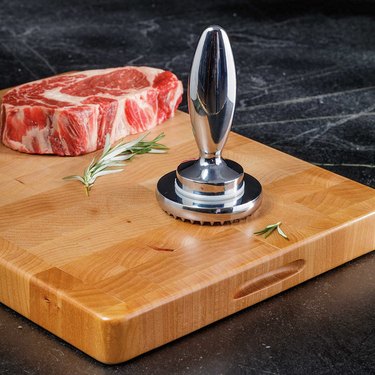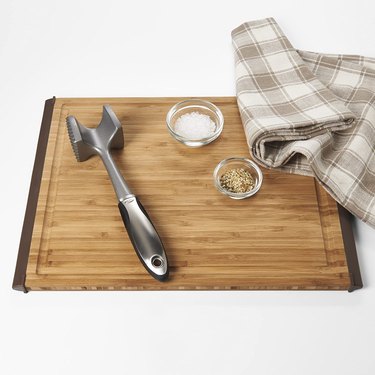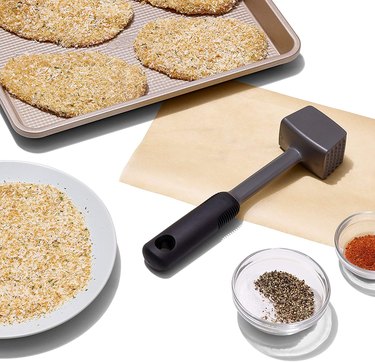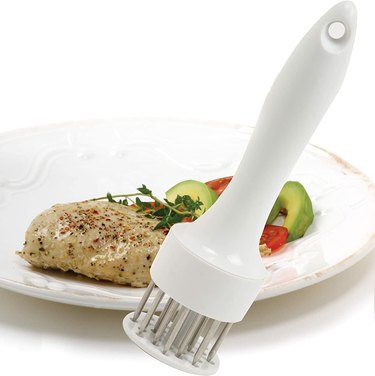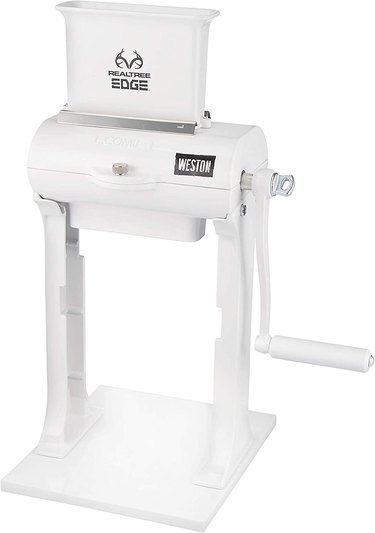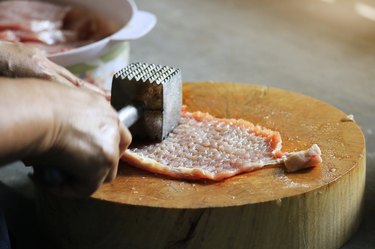
The meat counter is often the most expensive stop on your trip to the supermarket. There are decisions to be made here if you're shopping on a budget: Do you go with tender cuts—versatile and easy to cook, but pricier—or tougher-but-cheaper cuts that require some extra work? Do you splurge on choice beef, or settle for select?
If your tastes and your budget don't always agree, a good meat tenderizer can go a long way toward bridging the gap. They'll help turn tough pieces of meat into something you can actually enjoy eating, and do it at a price that (usually) pays for itself pretty quickly. So, which one should you get and why? Stay tuned as we break down the options for you, and select some of the best meat tenderizers on the market.
Video of the Day
Video of the Day
How Meat Tenderizers Work
Those cheaper cuts are naturally tough because the muscle fibers are dense and tightly bonded together, and in some cases (brisket, flank) are extra-long. Tenderizers work by either cutting those long fibers into shorter, chewable lengths (needle and blade tenderizers, or roller-based models); or by pounding and flattening the meat to tear and separate the muscle fibers (mallets and pounders).
Each of these techniques works, and each has its strengths. Hand-cranked tenderizers, which pass the meat between cylindrical rollers (with teeth like the ones that move a bicycle's chain), turn tough cuts into what supermarkets call "cube steak." The pounding and flattening technique works well with thinner cuts, so it's ideal for cutlets and schnitzel. Needle- and blade-type tenderizers are suitable for thicker cuts as well.
Needle and blade tenderizers have the added bonus of perforating the surface to a depth of a few inches, allowing brines and marinades to penetrate. That comes at a cost though because it allows any surface bacteria to penetrate into the meat as well. Tenderizing the meat immediately before you cook it is the safest option, or using a brine or marinade that's concentrated enough (or acidic enough) to inhibit microbial activity.
Points to Consider When Purchasing a Meat Tenderizer
So what do you need to think about when you're picking out a meat tenderizer? We have some thoughts:
Design: There are a few basic designs that most tenderizers follow. The simplest is an old-school mallet, typically with a smooth surface on one side of the head (for flattening) and pyramid-shaped teeth on the other (to actively tear and tenderize the toughest cuts). Vertical-handle pounders work in the same way, except the handle sits directly on top of the pounding head. The head is usually reversible, so it's very similar to a mallet in actual use.
Needle- and blade-type "Jaccard" tenderizers have dozens of sharp metal spikes that pierce the meat. They're just as capable of piercing your fingers, so safety features are often built-in. Cranked roller-style tenderizers mount to a countertop, and they're good for anyone who processes a lot of meat at once (hunters, homesteaders or even bulk-buying bargain hunters).
Materials: Old-school mallets were often made of wood (with or without a metal plate at the "business end"). Modern ones are usually made of metal and may have comfort-grip handles. Vertical-handle pounders are made of similar materials. Hand-cranked roller models are typically made of steel, though you'll see them in cast aluminum as well. Look for something that's durable and won't rust, and has as few joints and seams as possible (fewer places for bacteria to hide).
Cleanability: On a closely related note, you'll also want to consider how washable the tenderizer is. Mallets are relatively easy to clean, and often dishwasher-safe (wooden ones need hand-washing). Vertical-handle pounders vary widely; some are easy to clean and some aren't. Needle- and blade-type tenderizers often come with a brush to help get debris out of the needles or blades, and may or may not require hand-washing. With crank-type tenderizers (cubers), look for one that's easy to assemble and disassemble.
Actual Usage: The final (and most important) factor is your own usage. If you're a frugal cook wanting to turn one chicken breast into four breaded cutlets, a mallet or vertical pounder works just fine. The long handle of a mallet provides a lot of extra leverage, so that may be a factor if you're a smaller person or not as young as you once were. Demanding cooks who work with a lot of different cuts might favor a blade tenderizer for their versatility with large cuts. If you have the space for it and prepare big batches, there's a case to be made for a cuber. You might even end up with one of each, eventually.
So let's take a look at some specific examples of the different styles, and what makes them the best.
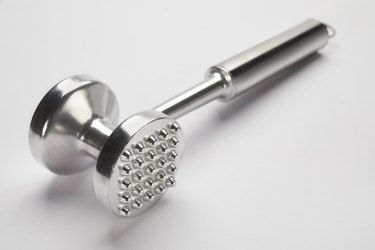
The Best Overall Meat Tenderizer
Keissco Reversible Meat Tenderizer and Pounder
There are lots of meat pounders on Amazon, so what sets the Keissco apart? Well, we like the size and weight. A lot of vertical pounders have smaller heads, in the 2 1/2- to 3-inch range. The "business end" of the Keissco checks in at nearly 4 inches in diameter, providing much better coverage, and at just under 2 pounds, it offers a good balance of heft and usability. The reversible head switches quickly from flat to spiked, and the chrome plating makes the whole unit dishwasher-safe (just remember to first take out the plastic gasket between the handle and the disc).
The Best Meat Mallet Tenderizer
OXO Good Grips Steel Meat Tenderizer
If you favor the mallet format over a vertical meat pounder, this is an outstanding choice. The main body of the mallet is solid cast aluminum, with a steel-and-plastic handle for comfort (because Good Grips). The head offers the traditional pairing of a flat side and a side with pyramidal teeth, but unlike most mallets, they're not parallel with the grip. OXO opted to set them at a slight angle, so you can hold your working hand above the counter but the head will be flat when it hits the meat (very clever!). The whole unit is dishwasher-safe, well balanced, and won't fatigue your arm and wrist during extended use.
The Best Value Meat Mallet Tenderizer
OXO Good Grips Meat Tenderizer
The OXO mallet is already lighter than our top-choice meat pounder (a mallet's swinging motion gives you more force, so it doesn't need to be heavy), but there's an alternative if you still find it too hefty. This smaller Good Grips mallet checks in at a mere 6 ounces (just over half of the steel mallet's weight), making it a better option for smaller cooks. The mallet is made of a hard polymer over a steel core, which explains the savings in weight and also makes it perfectly machine-washable. Like its big brother, this mallet has a slightly angled head for easier use. The only potential downside here is that the plastic outer shell probably won't prove as durable as metal. Still, at this price, it will more than pay for itself.
The Best Needle/Blade Meat Tenderizer
Chef Master Stainless Steel Blade Tenderizer
There are plenty of needle/blade tenderizers out there, and all of them work in much the same way: They push a bunch of 2-inch (or so) spikes into the meat to sever tough muscle fibers and strands of gristle. The Chef Master stands out from most of its competitors because of its big, comfortable handle, which makes the tenderizer especially easy to use. Like other blade-type tenderizers, you can use it on flat cuts (steaks and chops) or on bigger cuts including roasts, or pork shoulders and brisket (for barbecue enthusiasts). The blades are made of durable, non-corroding stainless steel, and the entire unit is dishwasher-safe.
The Best Value Needle/Blade Meat Tenderizer
Norpro Tenderizer Pro-BX
The problem with a lot of these tenderizers is storage. Either they're awkwardly long (mallets), large (cubers) or shaped (vertical pounders), or downright hazardous (most blade/needle models). So what are you to do if you're looking for something compact and safe, that can live happily in a drawer when you're not using it? Enter Norpro's Tenderizer Pro-BX. This one uses 24 sturdy pins (rather than the 48 blades on larger models) to tenderize the meat, and there's a spring-loaded protective cover to keep them away from your fingers. The whole device is relatively small and slender, so it fits neatly anywhere you care to leave it (and the finger-protector works just as well in storage). The only downside is that its small size means it'll take you longer to tenderize your steak.
The Best Meat Cuber Tenderizer
Weston Realtree 2-in-1 Jerky Slicer and Cuber/Tenderizer
Handheld meat tenderizers are great for occasional use, but if you frequently feed a crowd (or prep big batches of meats for other reasons) there's a case to be made for getting a cuber. Weston's hand-cranked Realtree cuber is arguably the best value in the bunch, with its interchangeable rollers providing a choice of meat-tenderizing or slicing blades. The unit attaches firmly to your work surface with a pair of clamps, so you can crank your way through tough meats without moving it. With the tenderizing blades in place, you can convert a stack of sliced meats into cube steaks in just moments, or you can switch to the cutting blade to crank out a mound of strips for jerky or stir-frying. There's a version without the slicer blade for a bit less, but this one's well worth the small premium in exchange for the added versatility.
